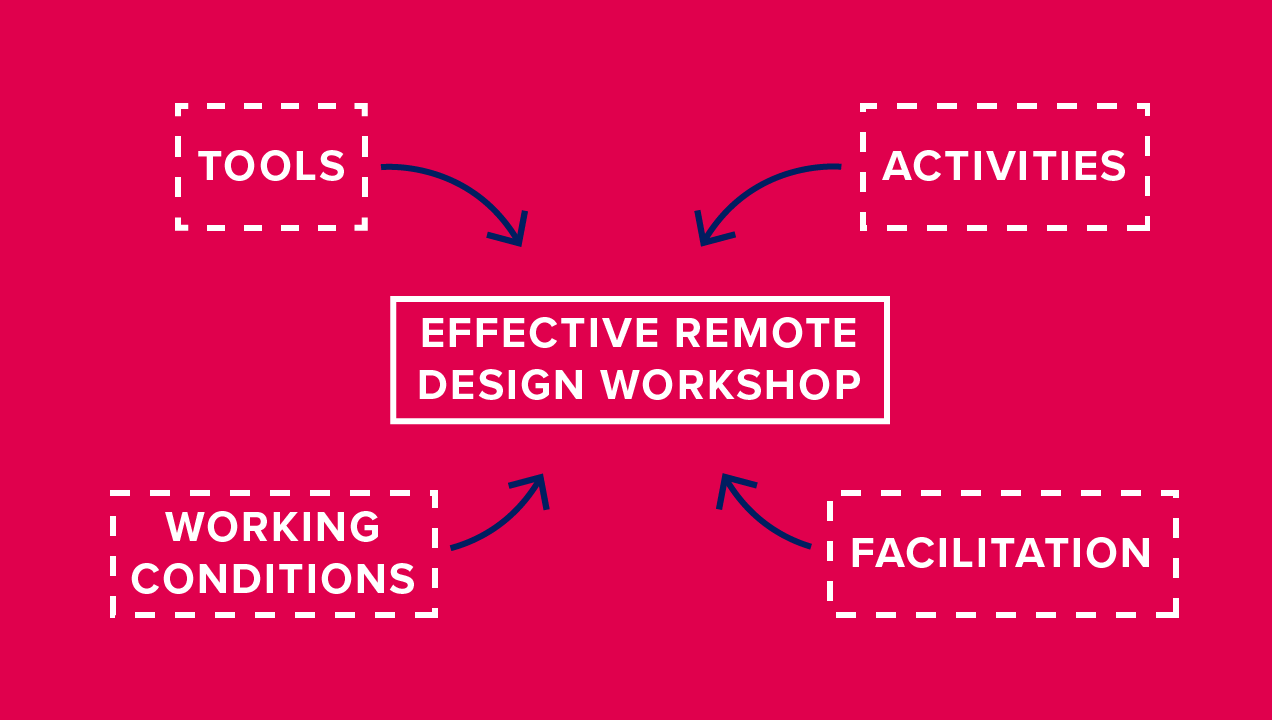Remote Design Workshops: Running the Workshop
When running remote design workshops it can be a challenge to keep teams motivated and engaged. Participant fatigue, distraction and continuity can jeopardize the attainment of your end goal. So how can you counteract this?

All image credit: Sutherland Labs
In Part 1 of this article we highlighted the importance of considering the working conditions of your team members, and how to pick the right tools for the job. In this part we are going to delve into two more aspects to consider when it comes to actually running the workshop – the activities you will use, and the facilitation style you need to adopt.
Mix familiar activities with new approaches
Getting started
- Have everyone upload and share a photo of themselves as an icebreaker. This is especially useful if there are members of the team that don’t know each other.
- Have everyone brain-storm ideas pre-workshop using a tool such as MURAL, then cluster and discuss. This helps start the workshop with content and lets people get familiar with the platform in advance.
Consider novel ways to co-design
- A designer can use a graphics tablet, or connect an iPad to their Mac and use an Apple Pencil to sketch at the direction of workshop attendees, or they can point their webcam to a pen and paper and sketch the old fashioned way.
- Attendees can sketch on paper, take photos with their phones and then send via email, Slack or another messaging tool (you’ll need to allow time for this). You can then post their sketches in real time collaboration on boards like Miro or MURAL.
- Consider creating a Slack group or other channel for workshops that may span multiple days. Links to the workshop calls can easily be shared along with updates and downloadable materials/references.
- Most conferencing systems are easy to download and use on the phone, allowing participants to use their phone camera to share any paper based materials with the rest of the group.
- Have a way to capture assignments and tasks team members need to follow up on after the workshop. Trello boards are a great tool for this.
- Use visual cues to have everyone vote on a subject. Thumbs up for yes, thumbs down for no, is a quick way to have everyone participate without going round the room one by one.
- Consider what to do with the assets after the workshop, how will you collate and integrate the designed assets and share with the client.
- If your participants are already familiar with collaboration tools such as Google Slides, Docs, and Sheets, these too are excellent, workable, tools. Ultimately it’s about your methodology rather than the tools themselves.
Consider ways to cater for breakout sessions
- They will be more difficult to manage, so will need extra planning in advance. Consider more individual tasks with share-outs to the group.
- For example, will you need multiple video conferencing accounts, one for each group? Does everyone know how to rejoin the main group again after they’ve broken out?
- Zoom (and other tools) provide breakout session options – experiment with these before the workshop so that you’re familiar, or ask someone who’s used the feature before to show you the process.
Have a process to allow each participant time to speak and share with the group, being careful of any potential few who could dominate the group conversation. Make a game of it and have the last participant nominate the next to speak. - Plan the break-out groups in advance. Plan for group dynamics and role splits. Avoid doing this on the fly.
Think about facilitation in the same way…and a little differently
- Plan an agenda for your attendees just as you would for an in-person workshop.
- In addition, have a detailed plan for yourself to hand so you’re clear what happens when and how long to spend on each activity.
- Ideally give yourself plenty of screen space. A mix of large monitors, multiple monitors and high resolution will help you manage the multiple apps and windows you’ll be juggling during the workshop.
- Think ahead of time how and when you’ll need all the apps and documents you’ll be using and organise them accordingly on your desktop. You can use multiple folders on your desktop with materials you’ll need for specific activities and label them clearly. E.g. one folder might be called “Ice breaker”, another might be called “Writing problem statement”.
- Also think about using multiple ‘desktop spaces’ and organise your most used tools in them.
- Have some snacks and a drink to hand to help keep up your energy levels
Taking all of these aspects into account may take a little longer up front, but they will help you improve collaboration and productivity in the long run.
In light of current events we’ve refined our remote design services to better support clients. To find out more visit our Remote Services page.
